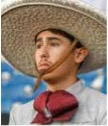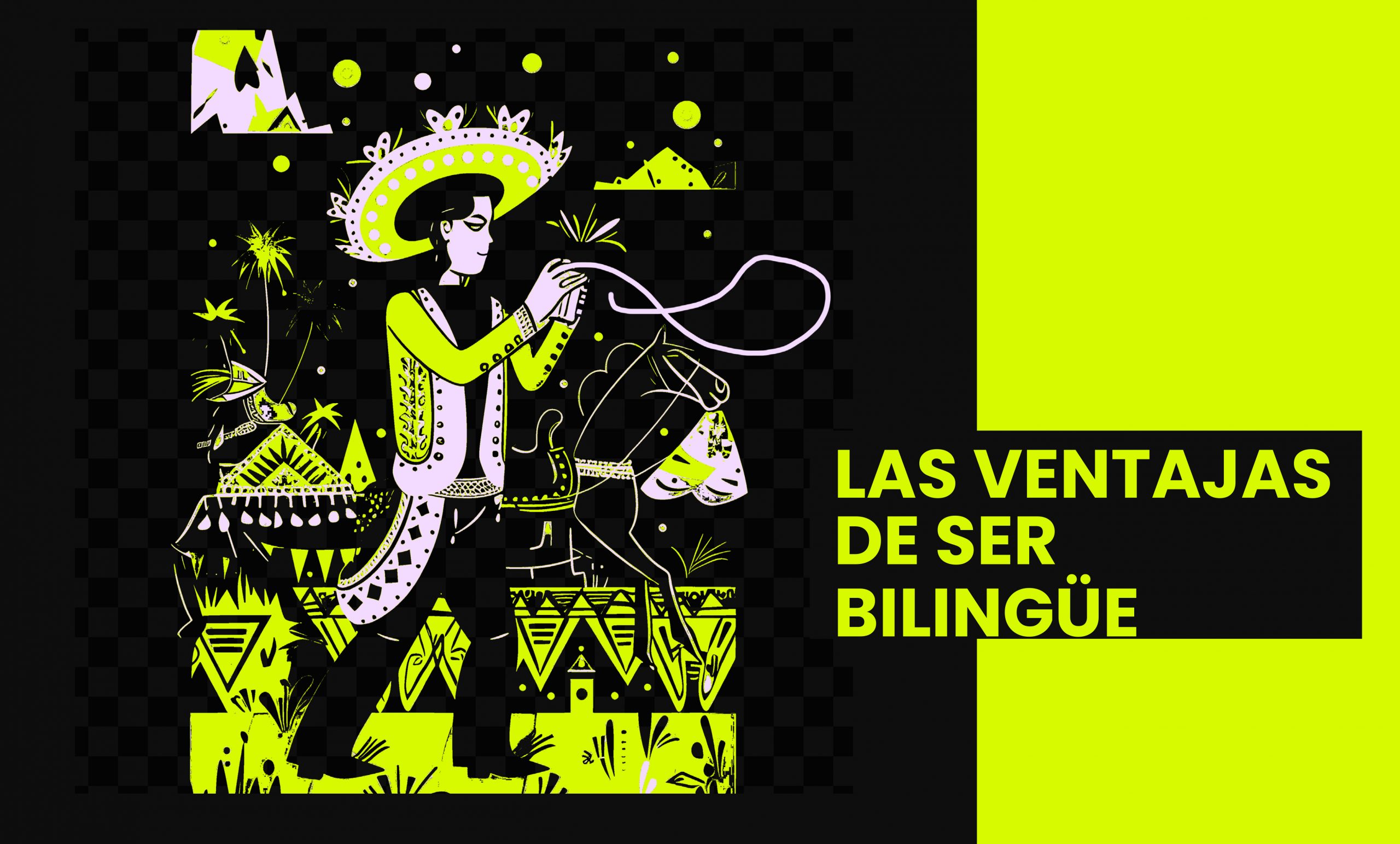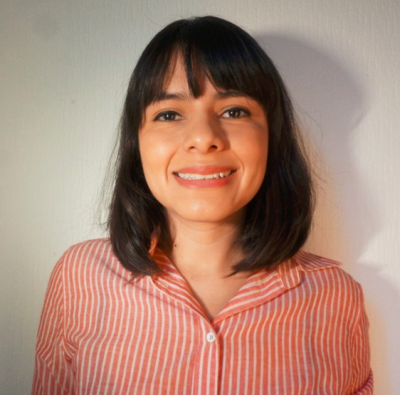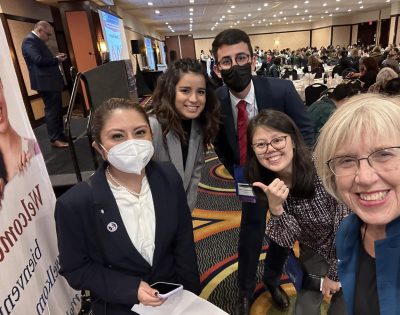CABE 2024 Student Writing Awards for K-12
Para festejar a las niñas y niños bilingües les invitamos el hermoso texto de Joaquín Pérez, participante del Student Writing Awards for K-12, y quien nos comparte de una manera imaginativa y significativa, las ventajas de ser bilingüe.

JOAQUÍN
PÉREZ
12th Grade Maestra: Anita Arias
Norco High School Corona-Norco Unified School District
The Essence of My Hands in a Bilingual World
Have you ever looked at your hands? If you haven’t, take a minute to pause and look at your hands. Does the skin on your hands bear themarks of labor? Can you feel the calluses and roughness that tell the story of consistent hard work? Does the texture of your hands display atestament to hours spent engaged in manual tasks and physical labor? Do your hands convey a sense of resilience and determination as theywork tirelessly every day? Do your hands remind you of the tenderness of your touch? The hands that not only tolerate pain but are capableof expressing care and gentleness. Our hands provide us with an essence that determines our character and an indispensable quality ofsomething.
For me, the essence of my hands provides me with more than texture and toughness. When I look at my hands, I see strength. I see scars and imperfections. I see precision and resilience. I see marks of pain. I see experiences as a bilingual individual that have allowed me tobridge gaps with my community. I see how these hands have allowed me to build connections with individuals from various ethnicities. Ifyou look at my hands, you can see the vibrant tapestry of my life.
My hands have allowed me to bridge gaps within my community. My hands are the hands of an athlete. My hands bear characteristics thatreflect the specific demands of the sport I train in. My hands are charro hands. What are charro hands you may ask? A charro is known as aMexican cowboy. Being involved in the sport of charrería has allowed me to bridge gaps between the American Rodeo and Mexican Rodeo.With these hands, I have been able to demonstrate the art of trick roping and educate others how this art is one of Mexico’s longest standingtraditions. I’m proud to say that very few are able to use a rope to express an art that is so delicate and beautiful. Skillful roping is atradition that has been passed down from my great-grandfather. Being involved in the sport of charrería has enabled me to educate mycommunity about its traditions and importance to our culture. It’s my mission to continue practicing the sport but also teach others about itso the traditions won’t fade away. Instead of letting the history of rodeo fade, my hands will continue to showcase the sport whether I’m onAmerican soil or Mexican soil. Whether I’m performing in American rodeo or Mexican rodeo, my hands will continue to show respect byplacing my hand over my heart to salute the American flag or salute the audience with my hand next to my hat brim during a charreada. Theessence of my hands in a bilingual world has allowed me to bridge communication gaps, reduce misunderstandings, and promote a moreinclusive and cohesive community.
My hands have allowed me to build connections with individuals from other ethnicities. The movements of our hands convey a wide rangeof emotions. My hands have allowed me to show respect. In some cultural contexts, the way individuals shake hands or hold hands duringcommunication can carry specific meaning. I’ve been taught to always give a firm grip as it can communicate sincerity, strength, and a senseof presence. Your hands have the power to hurt others but at the same time have the power to help others. I believe it is important to giveback to the community. For me, this is dear to my heart. Every year, my hands provide organizations that support children or women battlingcancer with a monetary donation. What makes this donation special is that I don’t just give the organization money from my bank account, Iwork hard to earn the money. Using my bilingual skills, I present my agricultural animal project to various businesses, community members,friends, and family to convince them to donate towards my project. My bilingual skills have allowed me to earn the respect and support formy project. I’m proud to announce that this year, the essence of my hands and bilingual skills allowed me to donate $1,000 to a charitableorganization in my community that will support women battling breast cancer. The essence of my hands in a bilingual world has enabledme to understand different cultures and have a deeper appreciation for diversity in my community. In addition, being bilingual enables theessence of my hands to show empathy for others.
My experiences have contributed to the vibrant tapestry of my family and community. My hands reflect the vibrant tapestry of my cultureand traditions. The vibrant tapestry of my life is rooted in strong family traditions and cultural expressions. My hands serve as a visualrepresentation of the passion, emotion, and pride I feel when I put on my charro suit and ride my horse. The pride I see in my parent’s eyes asthey cheer me on from the stands. My vibrant tapestry has a relationship with the land. The land that we use for our livestock to graze. Theland that we use to feed ourselves. The land that we call home whether it be here in the United States or another country, like in my case,Mexico. I’m proud to call two countries my home. These two countries have provided me with an aroma that has a sensory reminder of myclose interaction with the ranching lifestyle.
In summary, the essence of my hands in a bilingual world has helped me be more proud of my heritage and celebrate multilingualism. Themarks on my hands are badges of honor indicating a willingness to get one’s hands dirty in the pursuit of excellence which is somethingthat has been passed down from generation to generation. My hands are a canvas that tells the story of effort, persistence, and a commitmentto showcase my culture. This significance is deeply ingrained in my daily life and cultural practice.
La esencia de mis manos en un mundo bilingüe
¿Alguna vez te has mirado las manos? Si no lo has hecho, tómate un minuto para hacer una pausa y mirar tus manos. ¿Tiene marcas del trabajo fuerte la piel de tus manos? ¿Puedes sentir los callos y la aspereza que cuentan la historia de un trabajo duro yconstante? ¿Muestra la textura de tus manos un testimonio de las horas dedicadas a tareas manuales y trabajo físico? ¿Transmiten tus manos una sensación de resiliencia y determinación mientras trabajan incansablemente todos los días? ¿Recuerdan tus manos la ternura de tu tacto? Las manos que no sólo toleran el dolor, sino que son capaces de expresar cariño y dulzura. Nuestras manos nosaportan una esencia que determina nuestro carácter y una cualidad indispensable.
Para mí la esencia de mis manos me demuestra más que textura y dureza. Cuando veo mis manos, veo fuerza. Veocicatrices e imperfecciones. Veo precisión y resiliencia.
Veo marcas de dolor. Veo experiencias como persona bilingüe que me han permitido cerrar brechas con mi comunidad.Veo cómo estas manos me han permitido establecer conexiones con personas de diversas etnicidades. Si miras mis manos podrásver el tapiz vibrante de mi vida.
Mis manos me han permitido cerrar brechas dentro de mi comunidad. Mis manos son manos de atleta. Mis manos tienencaracterísticas que reflejan las exigencias específicas del deporte que entreno. Mis manos son manos de charro. ¿Te preguntarás, qué son las manos de charro? A un charro se le conoce como vaquero mexicano. Estar involucrado en el deporte de la charrería me ha permitido cerrar brechas entre el Rodeo Americano y el Rodeo Mexicano. Con estas manos, he podido demostrar el arte de la reata y educar a otros sobre cómo este arte es una de las tradiciones más antiguas de México. Me enorgullezco en decir que muypocos son capaces de utilizar una cuerda o reata para expresar un arte tan delicado y hermoso. La habilidad con la reata es unatradición heredada de mi bisabuelo. Estar involucrado en el deporte de la charrería me ha permitido educar a mi comunidad sobre sustradiciones y la importancia para nuestra cultura. Mi meta es seguir practicando el deporte, pero también enseñarlo a otros para que lastradiciones no desaparezcan. En lugar de dejar que la historia del rodeo desaparezca, mis manos seguirán mostrando el deporte ya seaque esté en tierra estadounidense o tierra mexicana. Ya sea que esté actuando en un rodeo estadounidense o en un rodeo mexicano, mismanos seguirán mostrando el respeto como colocando mi mano sobre mi corazón para saludar a la bandera estadounidense osaludando al público con mi mano junto al ala de mi sombrero durante una charreada. La esencia de mis manos en un mundobilingüe me ha permitido cerrar brechas de comunicación, reducir malentendidos y promover una comunidad más inclusiva ycohesionada.
Mis manos me han permitido establecer conexiones con personas de otras etnicidades. Los movimientos de nuestras manostransmiten una amplia manera de emociones. Mis manos me han permitido mostrar respeto. En algunos contextos culturales, laforma en que las personas se dan la mano o se toman de la mano durante la comunicación puede tener un significado específico. Mehan enseñado a dar siempre un saludo de mano firme, ya que el saludo puede transmitir sinceridad, fuerza y sensación de presencia.Tus manos tienen el poder de lastimar a otros, pero al mismo tiempo tienen el poder de ayudar a otros. Creo que es importante dar a lacomunidad. Para mí esto es algo muy importante en mi corazón. Cada año, mis manos han donado dinero a organizaciones queapoyan a niños o mujeres que luchan contra el cáncer. Lo que hace que esta donación sea especial es que no solo le doy a laorganización dinero de mi cuenta bancaria, sino que trabajo duro para ganar ese dinero. Usando mis habilidades bilingües, presento mi proyecto agrícola de animales a varias empresas, miembros de la comunidad, amigos y familiares para convencerlos de que donen dinero hacia mi proyecto. Mis habilidades bilingües me han permitido ganarme el respeto y el apoyo para mi proyecto. Meenorgullece anunciar que este año, la esencia de mis manos y mis habilidades bilingües me permitieron donar $1,000 a unaorganización benéfica en mi comunidad que apoya a las mujeres que combaten el cáncer de mama. La esencia de mis manos en unmundo bilingüe me ha permitido comprender diferentes culturas y apreciar más profundamente sobre la diversidad en micomunidad. Además, ser bilingüe permite que la esencia de mis manos muestre empatía por los demás.
Mis experiencias han contribuido al vibrante tapiz de mi familia y mi comunidad. Mis manos reflejan el vibrante tapiz de mi cultura y tradiciones. El vibrante tapiz de mi vida tiene raíces fuertes en tradiciones familiares y expresiones culturales. Mis manos sirven como representación visual de la pasión, emoción y orgullo que siento cuando me pongo mi traje de charro y monto mi caballo. El orgullo que veo en los ojos de mis padres cuando me animan desde las gradas. Mi tapiz vibrante tiene una relación con la tierra. La tierra que utilizamos para que pastoree nuestro ganado. La tierra que utilizamos para alimentarnos. La tierra quellamamos hogar ya sea aquí en Estados Unidos u otro país, como en mi caso México. Estoy orgulloso de llamar a dos países mi hogar. Estos dos países me han proporcionado un aroma que recuerda sensorialmente mi relación con el estilo de vida ganadera.
En resumen, la esencia de mis manos en un mundo bilingüe me ha ayudado a estar más orgulloso de mi herencia y a celebrar elmultilingüismo. Las marcas en mis manos son insignias de honor que indican que hay que ensuciarse las manos en la búsqueda de la excelencia, algo que se ha transmitido en familia de generación en generación. Mis manos son un lienzo que cuenta la historiadel esfuerzo, la perseverancia y el compromiso de mostrar mi cultura. Este significado está profundamente arraigado en mi vidadiaria y en mi práctica cultural.





